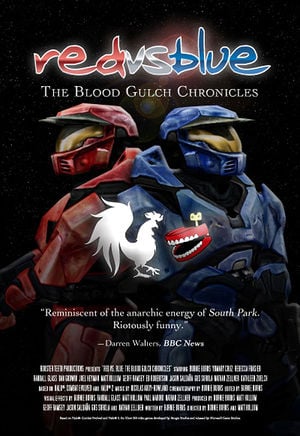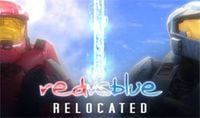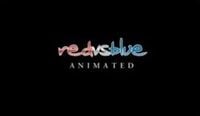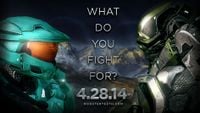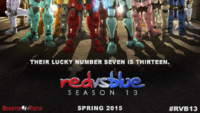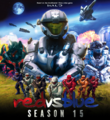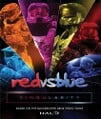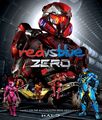Red vs. Blue
From Halopedia, the Halo wiki
| This article contains information about a fan-made subject that is not considered a part of the official Halo universe. |
| There is more information available on this subject at Red vs. Blue on the English Wikipedia. |
| “ | In the distant future, ten soldiers battle for control of the least desirable piece of real estate in the known universe- a box canyon in the middle of nowhere. | ” |
Red vs. Blue, often abbreviated as RvB, is a machinima series created by Rooster Teeth Productions. The story centers around the adventures of two teams composed of simulation soldiers. The series is primarily produced using the machinima technique of synchronizing video footage from a game to pre-recorded dialogue and other audio. Footage is mostly from the multiplayer modes of Halo: Combat Evolved and its sequels and prequel, Halo 2, Halo 3, Halo: Reach, Halo 4, Halo 5: Guardians, and Halo Infinite.
The series is published by Rooster Teeth Productions, originally available for download per episode at their site and later released on DVD. Praised for its originality, the series has won a total of four awards from the Academy of Machinima Arts & Sciences. Although mainly a satirical and absurdist comedy, the show often touches on deeper philosophy about the meaning of war when it comes down to individual soldiers; as well as other more serious themes such as human morals in the face of extinction and the humanity of artificial intelligence. The characters occasionally question the validity of their mission and whether or not it accomplishes anything, a common theme in commentary about the ethics of war.
Characters[edit]
The show's cast divides into several factions, but the story focus itself on a group named "the Reds and Blues", who originally were assigned to Blood Gulch to fight each other. Despite the enmity the Red and Blue Team members are supposed to harbor for one another, this usually does not apply personally to the enemy soldiers, who often engage in one-on-one conversation. The groups that appeared in the story are/were:
- The Reds and Blues
- Project Freelancer
- UNSC
- The New Republic
- The Federal Army of Chorus
- Charon Industries and their Space Pirates allies
- The Blues and Reds
- The Cosmic Powers
- Agents of Chrovos
- Shatter Squad
- Zero's Syndicate
Plot summary[edit]
The Blood Gulch Chronicles[edit]
Season 1[edit]
- Main article: Red vs. Blue: The Blood Gulch Chronicles (Season 1)
The Blood Gulch Chronicles begins with the introduction of two rookies on the Red and Blue teams, also getting a jeep and a tank respectively. While the Red Team leader, Sarge, was at Red Command, the Red recruit, Donut, is sent on a fool's errand by his fellow soldiers(Simmons and Grif), only to accidentally steal the enemy flag when he believed it to be the store (and the Blue rookie Caboose believing Donut to be the General foretold in the fool's errand of his own). The weeks of reconnaissance and intelligence gathering breaks down into chaos and poorly constructed offensives.
Season 2[edit]
- Main article: Red vs. Blue: The Blood Gulch Chronicles (Season 2)
Several months after the first season, a medical officer, named Frank Dufresne, arrives to check on the wounded soldier Blue team reported. He had come months afterward, so by the time he got there, the wounded soldier (Tex) had already died. Almost immediately after his arrival the Red team attacks. Red team salvages their failed attack by getting Doc as an exchange for Blue team's surrender (although he was ordered to go to Red team anyway). Doc's added involvement in the canyon, combined with a rampant AI infecting Caboose will force the two opposing teams to do the unthinkable.
Season 3[edit]
- Main article: Red vs. Blue: The Blood Gulch Chronicles (Season 3)
The Red and Blue armies believe to have found themselves in the future. They have stumbled upon a prophecy which says a blue being will destroy a large 'temple'. They are trying to defend from an attack from O'Malley when this 'Great Destroyer' arrives.
Season 4[edit]
- Main article: Red vs. Blue: The Blood Gulch Chronicles (Season 4)
Following a distress signal back to Blood Gulch, the Red team experiences a falling out with one of their soldiers. Tucker, Tex, Caboose, and the alien go on quest to save the alien's race. Tex does not return to Blood Gulch with the rest of Blue team, and Tucker becomes seriously ill.
Out of Mind[edit]
- Main article: Red vs. Blue: Out of Mind
Out of Mind is a mini-series that took place in-between Season 4 and Season 5. It is a narrative from Tex's point of view, told in a much more serious tone. Its events precede both Season 5 and Recovery One.
Season 5[edit]
- Main article: Red vs. Blue: The Blood Gulch Chronicles (Season 5)
A ship from Earth has crash-landed in the middle of the canyon on top of Donut, bringing a new soldier, Grif's sister. Red team experiences a major crisis in their chain of command and Blue team welcomes a new addition to the family. Church tries to stop O'Malley once and for all.
The series finale was distributed with three alternate endings; the ending which was shown to a viewer depended on which link in Burnie Burn's post they followed to watch the episode. An additional three endings were included in the special features of the Season 5 DVD.
Recollections[edit]
Recovery One[edit]
- Main article: Red vs. Blue: Recovery One
Recovery One was a Red vs. Blue miniseries distributed via Xbox LIVE and the internet that takes place after Out of Mind as well as before and during Season 5. Its plot revolves around Agent Washington, also known as Recovery One, who is a Freelancer like Tex, Wyoming, and York. Washington's job is to recover all Freelancer AI constructs of freelancers killed in action.
Reconstruction[edit]
- Main article: Red vs. Blue: Reconstruction
Reconstruction is the direct sequel to the Blood Gulch Chronicles, exploring the causality of events from both The Blood Gulch Chronicles and Recovery One. It continues to follow Recovery Agent Washington's journey tracking down a mysterious enemy called the Meta, who is killing Freelancers and taking their armor enhancements and AIs. First, Wash has to find the people with the knowledge and experience to help him; the former occupants of Blood Gulch. With Project Freelancer under government investigation, Washington soon begins to realize what Church really is, and the nature of his role in the project.
Relocated[edit]
- Main article: Red vs. Blue: Relocated
Relocated is a direct sequel to Reconstruction, following the Red Team, now on Valhalla, struggling to do the usual nothing, and Caboose's strange action's at Blue Base drawing further attention to himself.
Recreation[edit]
- Main article: Red vs. Blue: Recreation
Recreation is a direct sequel to Relocated and Reconstruction. As the Reds continue to try and figure out what Caboose is up to and wake up a comatose Donut, Caboose continues trying to make a new best friend. Caboose decided to head to a desert in search of Tucker, and Sarge and Grif agreed to go with him, unbeknownst to the chaos they are about to get drawn into. Meanwhile, an old enemy pays an unexpected visit to Valhalla.
Revelation[edit]
- Main article: Red vs. Blue: Revelation
Revelation is a direct sequel to Red vs. Blue Recreation. Washington and the Meta have teamed up to find the missing Epsilon AI, killing most of the Reds in Valhalla, leaving Simmons and Doc prisoner. Sarge and Grif managed to rescue Simmons, and the entire cast follow Caboose and Epsilon to a Freelancer storage facility. There, they meet an old friend, who will spark up a dangerous confrontation between the good, the bad, and the indifferent.
Project Freelancer[edit]
Season 9[edit]
- "Before there was Red vs. Blue, there was Project Freelancer."
- — Season 9 tagline
- Main article: Red vs. Blue: Season 9
Season 9 begins with Epsilon in the storage unit, experiencing similar events in The Blood Gulch Chronicles. Along with this, a new Freelancer back story was also shown, detailing the history of Project Freelancer, namely the events when Tex joins the group. As Epsilon search for Epsilon-Tex in the damaged memory unit, he realizes what the Director and the Alpha couldn't. The two plots are told simultaneously.
Season 10[edit]
- "The biggest season ever. Of all time."
- — Season 10 Tagline
- Main article: Red vs. Blue: Season 10
Season 10 continues both plots told in Season 9. The past storyline will show the conclusion of Project Freelancers' quest to defeat a rogue Insurrection group and the lost of complete trust between the Freelancer agents and AIs. The present storyline picks up right where Season 9 left off, as Epsilon-Church joins the Reds and Blues on Agent Carolina's quest for vengeance against the Director of Project Freelancer.
Chorus Trilogy[edit]
Season 11[edit]
- Main article: Red vs. Blue: Season 11
Set sometime after Season 10, Season 11 follows Sarge, Grif, and Simmons of Red team and Caboose, Tucker, and Washington of Blue team as they are being transported home after being pardoned for helping bring down Project Freelancer. Unfortunately, the transport crash lands at an unknown location (most likely caused by the combined faults of everyone). Knowing that they'll be stranded for sometime, the Reds and Blues begin building their bases and wait to be rescued. This season takes the series back to its roots: only use the game engine without using CGI.
Season 12[edit]
- "What do you fight for?"
- — Season 12 tagline
- Main article: Red vs. Blue: Season 12
Season 12 continues where the previous left off, with Tucker, Grif, Simmons, and Caboose joining the New Republic, and with help from Rebel leader Vanessa Kimball and mercenary Felix they attempt to rescue Sarge, Donut, Wash and Lopez, who were captured by Locus and the Feds at the end of the previous season. Also in the civil war is Agent Carolina, whose true intentions in the conflict and special interest with a crate remains a mystery. This season also marks the return of CGI in the series, which is blended in with machinima, similar to Revelation.
Season 13[edit]
- "Their lucky number seven is thirteen."
- — Season 13 tagline
- Main article: Red vs. Blue: Season 13
Season 13 is a direct follow-up to Season 12 and the last season of the Chorus Trilogy, in which the Blood Gulch Crew, the New Republic and the Federal Army of Chorus join forces to go to war against Chairman Malcom Hargrove and his space pirates. While this season is the last of the Chorus Trilogy, it doesn't fully conclude the story of many characters, including most members of the Blood Gulch Crew, Locus and the inhabitants of Chorus.
Season 14: Anthology[edit]
- Main article: Red vs. Blue: Anthology
This anthology features a collection of short stories focused on various characters, factions, and events in the Red vs. Blue universe rather than an episodic storyline. This is also the first season to be written by a combination of both in-house writers and writers residing outside of Rooster Teeth.
The Shisno Trilogy[edit]
Season 15[edit]
- "A series of violent attacks across human space has people demanding answers. Who are these Reds and Blues? And why are they so bloody ruthless? One reporter sets out to uncover the truth, determined to find out why the once beloved Reds and Blues have turned so malicious, taking her on a galaxy-spanning adventure filled with many twists and turns."
- — Season 15 synopsis
- Main article: Red vs. Blue: Season 15
Season 15 acted as a follow-up to Season 14, focusing on a reporter who is searching the reason of why the Reds and Blues have betrayed the galaxy.
The Shisno Paradox[edit]
- "The award-winning, longest-running web series Red vs. Blue returns with season 16. Picking up in the moments after the conclusion of season 15, Red vs. Blue returns with a new saga, pitting the characters against powerful new foes and launching them back into an epic adventure unlike any other in the show’s history."
- — The Shisno Paradox synopsis
- Main article: Red vs. Blue: The Shisno Paradox
The Shisno Paradox is the sixteenth full season of Red vs. Blue, and the second part of the trilogy of the Reds and Blues' misadventures. Taking place right after the end of Season 15, the story will follow the Reds and Blues in a new adventure that threats the very structure of the universe.
Singularity[edit]
- "It took two seasons for the Reds and Blues to break the universe, but they’re about to discover that things can always get worse."
- — Singularity synopsis
- Main article: Red vs. Blue: Singularity
Singularity is the seventeenth full season of RvB and the final season of The Shisno Trilogy. It follows Donut's efforts to save his friends and the universe from Chrovos and Genkins. While this season is the last of the Shisno Trilogy, it fully conclude the story of many characters, including most members of the Blood Gulch Crew, Locus, and the inhabitants of Chorus.
Zero[edit]
- "RvB meets Fast & Furious"
- — Zero synopsis
- Main article: Red vs. Blue: Zero
Zero is the eighteenth full season of RvB. Zero focused on a new cast of characters, under the team named "Shatter Squad", who fights against an organization led by someone named "Zero". Due to the negative reception the season had, the storyline set up in Zero was scrapped, and development on a different storyline was took by Rooster Teeth.
Restoration[edit]
- "When the universe’s greatest villain returns in a terrifying new form, old adversaries, the Reds and Blues of Blood Gulch, will have to set aside their differences to save the galaxy one last time."
- — Restoration synopsis
- Main article: Red vs. Blue: Restoration
Announced on July 7, 2023, Restoration was announced as the nineteenth and final full season of RvB, bringing Burnie Burns back as the final season's writer and Matt Hullum as season's director. Restoration takes place right at the end of Season 13, re-canonizing The Shisno Trilogy and Zero as simulations run by Epsilon in his last living moments while he tries to make sure his friends will make out alive in the unforeseable future. When an old enemy returns, the Reds and Blues must join forces one last time. Originally planned to be released in an episodic schedule, Restoration was instead released as a full-length film as result of Rooster Teeth Productions being shut down by Warner Bros. Discovery.
Other[edit]
Public Service Announcements[edit]
Rooster Teeth made numerous PSAs, including for Xbox LIVE's partnership with Rock the Vote in late-summer 2008 and even for the United States Presidential election. These PSAs are usually told from the real-world's point of view, and are obviously done for laughs.
Game Previews[edit]
Rooster Teeth has done miniseries with the characters previewing Halo 3: ODST, Halo: Reach, and Halo 4.
Maxi Series[edit]
There are two Maxi series, both only available on Halo Waypoint until April 2015, when Rooster Teeth registered a YouTube channel for Red vs. Blue.
MIA
- Main article: Red vs. Blue: MIA
MIA is a 6-episodes miniseries released to celebrate and promote the launch of Halo: Combat Evolved Anniversary. It was first mentioned in August 2011, during Halo Fest, where the cast had a table read of the series first three episodes' scripts, as well as some improvised comedic lines.[1] The first episode was released on Halo Waypoint in November 2011.
The series follow the Reds and Blues as they search for Grif, who is missing, at the same time exploring the multiplayers maps included in the Anniversary Map Pack.
Where There's a Will, There's a Wall
- Main article: Red vs. Blue: Where There's a Will, There's a Wall
Where There's a Will, There's a Wall, shortened "Red vs. Blue: Wall", is a 3-episodes miniseries relating to the Reds attempting to find out what is behind the wall in Hemorrhage, while the Blues receive a Falcon transport as a shipment and what they plan to do with it.
The Best of Red vs. Blue Awards[edit]
- Main article: The Best of Red vs. Blue Awards
The Best of Red vs. Blue Awards, also known as "The Best Red vs. Blue. Ever. Of All Time", is a special video of Red vs. Blue that presents the series' most memorable moments (from Season 1 to Season 9) - as voted by the fans - and is presented in an award show type style. The special also features numerous Red vs. Blue and Grifball miniseries characters.
RvB 360[edit]
- Main article: Red vs. Blue 360
Red vs. Blue 360 is a series of short videos that utilizes YouTube's 360º feature. It features the Reds and Blues's shenanigans on Blood Gulch.
Family Shatters[edit]
- Main article: Red vs. Blue: Family Shatters
Red vs. Blue: Family Shatters is a non-canon spinoff of Red vs. Blue: Zero, featuring both members of Shatter Squad and Viper syndicate in slice-of-life shorts.
QvsA[edit]
- Main article: Red vs. Blue: QvsA
QvsA is a series of special episodes hosted by Grif and Simmons, where they try to answer questions about Red vs. Blue.
Development history[edit]
Rooster Teeth stated that they were inspired by Randall Glass' Warthog Jump video, which made them realized that they can create a web series with a video game.
The writing process for the series has changed over time. Early in season 1, Burns wrote the episode scripts from week to week, with what appeared to be minimal planning in advance; major plot events seemed to have been conceived shortly before they were filmed.[2] For the second season, Matt Hullum became a main writer.[3] A rough plot outline is now written before a season begins, although the actual content of an individual episode is still decided on a more short-term basis. Shortly after episode 2 was released, Rooster Teeth was contacted by Bungie Studios. To their surprise, Bungie loved the series. A deal was made to allow Rooster Teeth to make the series without licensening fees. However, contradictory to this, Burnie claims that the major plot ideas were decided by episode 6, the episodes just didn't contain much information - they originally went for comedy rather than depth. Because Red vs. Blue is loosely based on the Halo universe, Rooster Teeth encountered some difficulties when trying to synchronize events in the series with the release of Halo 2.
Aside from a few scenes created using Marathon: Infinity, Marathon 2, and Halo: Combat Evolved for PC, Red vs. Blue is mostly filmed with interconnected Xbox consoles. As the series title suggests, the original chronicles are largely set in the multiplayer map Blood Gulch and the later series are set in Blood Gulch successors in Halo 2, Halo 3, and Halo: Reach. Within a multiplayer game session, the people controlling the avatars "puppet" their characters, moving them around, firing weapons, and performing other actions as dictated by the script, and in synchronization with the episode's dialogue, which is recorded ahead of time.
The "camera" is simply another player, whose first-person perspective is recorded raw to a computer. As the recording occurs within the game, a few different bugs and post-production techniques have been exploited in order to achieve desired visual effects. In particular, Adobe Premiere Pro is used to edit the audio and video together, impose letterboxing to hide the camera player's head-up display, add the titles and fade-to-black screens, and create some visual effects that cannot be accomplished in-game.[2]
By Red vs. Blue: Reconstruction, Rooster Teeth has retconned the events in the past five seasons, integrating the plot into the Halo canon, turning Red vs. Blue from a comedy to Halo fan fiction. The key comedy remains in the series, while actions scenes were added into the series. In 2009, Rooster Teeth remastered the first five seasons, removing the traditional HUD camera and combined all episodes into one single video.[4] As of Red vs. Blue: Revelation, Rooster Teeth had hired web-based animator Monty Oum to implement completely animated scenes into the series. The newly animated scenes uses in-game assets from the Halo series and allows much more storytelling possibilities.
Reception[edit]
Red vs. Blue is widely credited with attracting public attention to machinima. Although examples had existed since the 1990s, Clive Thompson, a journalist from New York Times, credits Red vs. Blue as "the first to break out of the underground".[5] In Halo 2, Bungie inserted a special command — a joystick button that makes a soldier lower their weapon — designed solely to make it easier for Rooster Teeth to do dialogue.
Rooster Teeth's success is recognized by Bungie. The Rooster Teeth crew was featured in the Halo 2 Collector's Edition's Bonus DVD, and the ViDoc O Brave New World. Along with several other exceptional Halo community members, Red vs. Blue was featured in the Halo: Reach Tribute Room easter egg. Red vs. Blue and Rooster Teeth were listed in the "Special Thanks" section of the Halo 3 credits, the Halo 3: ODST credits, and the Halo: Reach credits.
Since Bungie's departure from the Halo series, 343 Industries has taken the role of endorsing Rooster Teeth. 343 Industries often hosts Rooster Teeth at events such as Halofest 2011. Halo Waypoint posts multiple Red vs. Blue episodes each week. Rooster Teeth employees were listed in the "Special Thanks" section of the Halo 4 credits. In addition, Rooster Teeth was given the privilege to film the Season 10 finale in Halo 4 multiplayer at 343 Industries a day before the release of Halo 4.
Trivia[edit]
Homage from the Halo series[edit]
- On Bungie.net and Halo Waypoint, the Flag Kill medal's description, which is triggered by scrolling over the flag symbol, is "It's right next to the headlight fluid". This is a reference to episodes 3 and 4 of Blood Gulch Chronicles where the new recruit, Donut, is sent on a fool's errand to fetch "headlight fluid" and "elbow grease". Instead, he mistakenly goes to Blue Base and takes their flag.
- In the Halo 2 multiplayer map Beaver Creek, a faint message reading "Why Am I Here" can be seen on the wall, referencing the first line in Red vs. Blue.
- In Halo 3, the Password-lacking Marine involves a Marine and a voice behind a door arguing. Not only are the duo voiced by the Rooster Teeth crew, their arguments also make reference to Red vs. Blue lines.
- In Halo 3, Halo 3: ODST, and Halo: Reach, the Warthog's tires are printed with the word "PUMA". This is a reference to the second episode of Red vs. Blue, in which Grif commented that the Red Team's Warthog resembles a Puma rather than a Warthog.
- In the Halo: Reach radio conversation on Holdout, two characters can be heard discussing their "zombie plans," referencing the Red vs. Blue PSA Planning to Fail.
- In Halo: Glasslands, there are several references to the series:
- One of the ODSTs notes that their Sangheili prisoner Jul ‘Mdama sounds like he is saying "Blarg". This is a reference to the Sangheili, referred to as "aliens", in Red vs. Blue only saying "Blarg" and "Honk".
- The AI Black Box calls Evan Phillips "Phyllis", which was the original name of the Blue Team's tank's AI, Sheila.
- When Red team tricks someone and steals something by surprise, they would say "Yoink!" This was made into the Yoink medal in Halo: Reach. Whenever someone is performing an assassination and their target dies before the animation finished, that player gets the medal "Yoink!"
- One of Halo 4's Achievements is called "I <3 Red vs Blue", which can be obtained by winning 5 War Games. Another Achievement, Roses vs Violets, can be obtained by finding an Easter egg of the series during Spartan Ops.
- When the player shoots to a hidden box in a lava stream in Episode 1 Chapter 5 and get the achievement Roses vs Violets, Michael J. Caboose of Blue Team will slip in the radio transmissions between Sarah Palmer, Robert Dalton and Fireteam Castle.
- If the player shoot to a hidden box in Episode 2 Chapter 5, four characters (Church, Caboose, Grif and Simmons) can be heard in Audio Logs inside the facility, replacing Science Team Gagarin.
- If the player shoots a hidden box in Episode 3 Chapter 4, Simmons and Grif of Red Team can be heard as two pilots of the Mantis-carrying Pelicans.
- If the player shoots a hidden box in Episode 4 Chapter 2, Vic can be heard flirting with Palmer.
- If the player shoots a hidden box in Episode 5 Chapter 5, Sarge and Grif can be heard arguing over a Pelican which apparently carries cargo for Grifball (The subtitles mistakenly identify them as Caboose and Sarge).
- If the player shoots a hidden box in Episode 6 Chapter 4, when Fireteam Switchback contacts the UNSC Infinity, instead of SPARTAN Cara Costabile, Sarge (posing as a "Corporal Switchback") will be heard asking Infinity if their slipspace drive is running, followed by the usual punchline of "Better go catch it!". A few seconds later, Grif can be heard screaming "Baba-Booey!! Baba-Booey!!".
- If the player shoots a hidden box in Episode 7 Chapter 3, when Crimson is fighting against Jul 'Mdama's Covenant, Simmons will contact Command, saying there's a firefight in the engine room, and he needs Maintenance. Miller answers him that the Spartans will be there soon, to which Simmons responds sarcastically: "Oh great! More people with guns. I'm sure THAT will fix the engine."
- If the player shoots a hidden box in Episode 8 Chapter 2, after Miller tells Crimson that Dalton is sending more gear, Caboose will say "Six crates of elbow grease and headlight fluid inbound now!".
- If the player shoots a hidden box in Episode 9 Chapter 5, when Crimson activates one of Hawk Squad's IFF tags, Church will be heard discuss with a Sangheili, telling him that he does not understand what he says. The Elite, enraged, kills Church with an Energy Sword. This easter egg is a reference to the first chapters of Red vs Blue Season 4, where the Blue Team meets an alien and they have trouble understanding what the alien is saying.
- If the player shoots a hidden box in Episode 10 Chapter 3, when Crimson must aboard a Lich with jetpacks, Freelancer Agent Georgia will say "Cool, jetpacks! That'll help us get on that ship or my name isn't Agent Georgia". This Easter is a reference to a running gag in Season 10, in which Agent Georgia was involved in a terrible incident, due to not following "course correction" while using a jetpack and his body was never found. At the same time, that reference is heavily reminiscent of James-005's fate.
- One of Halo: The Master Chief Collection' achievements, specifically for Halo 2: Anniversary is called "Six Pedals, Four Directions", making reference to a recurrent gag in the show.
- Another achievement in Halo: The Master Chief Collection, although for Halo: Reach, "How Did I Lose All My Fingers?" references the short What I Did On My Summer Vacation, wherein Caboose takes the role of Noble Six in the Halo: Reach campaign.
- In Halo 5: Guardians, the description for the HCS Contender Red weapon skins reads "Let's all take dying as an open action item." This is a quote said by Simmons in the Season 2 finale, "K.I.T. B.F.F.".
- The "Lightish Red" AI Color in Halo Infinite is a reference to the character "Donut", who refers to his pink colored armor as "lightish red."
- In Halo Infinite occasionally while dropping off a Scorpion at a Forward Operating Base, Echo 216 will say, "Your Scorpion's on the way. By the way, her name's Sheila. Take care of her, Chief." The achievement Bring Sheila Home Safely is another reference to the same.
- In Halo Infinite, if the player has Mister Chief as his/her Spartan's Personal AI, and makes a kill with a plasma grenade, one of the two lines Mister Chief would say about it is "was that a blue spider?", being this a reference to a quote said by Donut in Season 1 Episode 11 "Knock, knock. Who's there? Pain".
- In Halo Infinite, if the player has the IWHBYD skull activated, Marines sometimes will ask Master Chief "Do you ever wonder why we're here?" This is in reference to the first line spoken in Red vs. Blue
References to the Halo series[edit]
- Most of the character names can be found in Halo: Combat Evolved's Temporary Profile feature. Out of the randomly generated names, Caboose, Church, Donut, Simmons, and Doc are commonly found. It is possible Rooster Teeth named their characters using this feature. This feature is continued in Halo 3, with names like Caboose and Donut showing up as temporary profiles.
- In episode 100 of The Blood Gulch Chronicles, when Tex takes off in the Pelican, the word "Marathon" is partially obscured on the underside. This is an obvious reference to Bungie's previous game series, Marathon, in appreciation from Rooster Teeth.
- Red vs. Blue paid homage to Bungie's love for seven. Some examples include Sister stating that she was close to having seven abortions, the Red Zealot from Battle Creek claiming that Caboose is the one who will "rule [them] for seven years", the Meta capturing seven artificial intelligence fragments in total, and Epsilon-Tex assaulting Grif's groin seven times.
- In the Red vs. Blue: ODST episodes Church says that he heard a rumor that Avery Junior Johnson can't be killed. This is an obvious reference to how in the games he is a plot critical character and is invincible.
- In Revelation Chapter 2, Sarge remarked that the "[pistols] aren’t effective as they used to be." This is a reference to how the M6 series lost its effectiveness drastically between Halo: Combat Evolved and Halo 3.
- In Revelation Chapter 20, a UNSC interrogator stated that "the budget only allows for one crashed Pelican per mission." This is a reference to the fact that every level (mission) in Halo 3 has at least one crashed Pelican (with the exception of Crow's Nest).
- All of the Freelancers were stripped of their real names and were given codenames based on the 50 US states, similar to the SPARTAN-IIs; with the only difference being that the SPARTANS kept their first names. As well, they each had a number system similar to the Spartans, though the only confirmed example is New York; F-12 (Foxtrot-12), with "F" for Freelancer instead of "S" for Spartan or Sierra.
- Another similarity between the SPARTANs and Freelancers is that the Freelancers were trained to fight the Insurrection, in almost the exact same way as the SPARTANs.
- Cortana gaining a split personality is similar to the Epsilon AI having one, although the two each had a different reason for gaining so (Rampancy for Cortana while holding all the other AI Fragments for Epsilon)
- In several episodes of Season 9, several Huragok symbols are seen in an object called the Sarcophagus, which is revealed in the Season 10 Episode 16 that the Sarcophagus contains a Huragok, which was an important factor in the creation of the Freelancer AIs.
- In Season 11 Episode 4, two scenarios of the obstacle course that Tucker runs are campaigns levels of Halo: Combat Evolved and Halo 4, these being "The Maw" and "Reclaimer", respectively.
- When Elites first appeared in the series, they were referred to only as "aliens" and bore little resemblance to the canon species in terms of behavior or culture. In Season 12, though, they are referred to as Sangheili for the first time.
- During Season 12, Locus thinks that soldiers and humans are two different things, making a reference to John-117' statement in Halo 4's Epilogue.
- Season 15 synopsis is extremely similar to the premise narrated by the first season of Hunt the Truth.
- In Season 15 Episode 11, Tucker is shown playing the level "A New Enemy" from Halo Wars 2.
Miscellaneous[edit]
- Red vs. Blue, was originally intended to last only six installments, but its popularity led to the production of 100 episodes of The Blood Gulch Chronicles, and more seasons afterwards.
- The popular Double EXP Weekend game type "Grifball" is based on Sarge's line from episode 59 of Red vs. Blue.
- Red vs. Blue met Fortnite streamer Ninja in a short during Fortnite's build up to the release of Master Chief as a skin in-game.
Gallery[edit]
Sources[edit]
- ^ Halo Waypoint: Red vs. Blue Table Read
- ^ a b Red vs. Blue Season One: Audio Commentary
- ^ Red vs. Blue Season Two: Audio Commentary
- ^ Rooster Teeth: RvB: The First Five Seasons Box Set - Remastered Edition
- ^ The New York Times: The Xbox Auteurs
See also[edit]
Internal links[edit]
External links[edit]
- Rooster Teeth: Red vs. Blue
- Rooster Tooths, the Unofficial Red vs. Blue Resource Site
- RvB Wiki, the Red vs. Blue Wiki
- Red vs. Blue on Wikipedia
- Wikiquote: Red vs. Blue
| |||||||||||||||||
